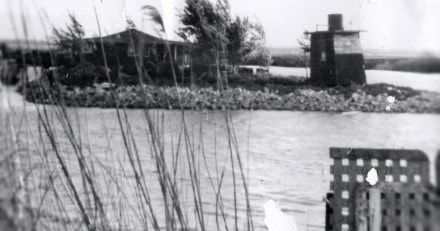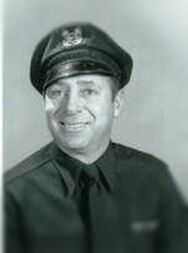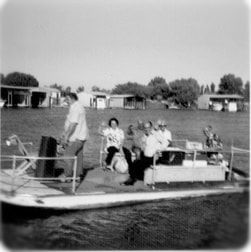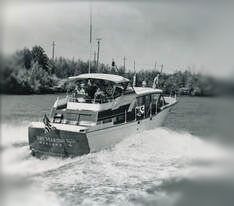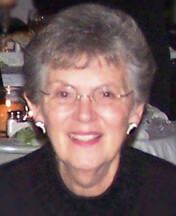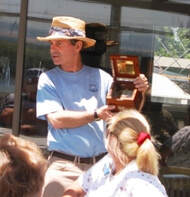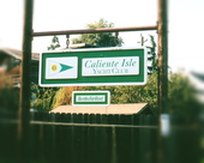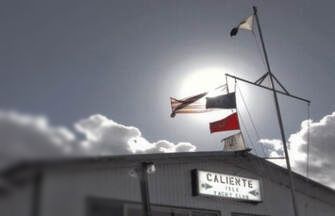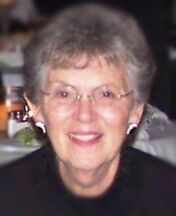Vision and Lots of Hard Work Tell the Story
Written By:
Fred Shaw (1981) and Jo Anne Shaw Lyman (2007)
Fred Shaw (1981) and Jo Anne Shaw Lyman (2007)
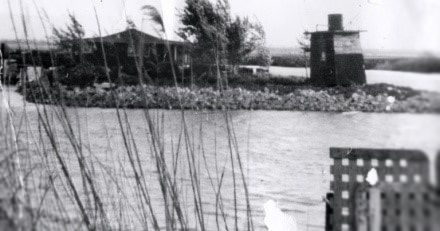
Once just a small, wind blown island in the middle of Taylor Slough, it took vision and a lot of hard work to create Caliente Isle Yacht Club. The early visionaries were a group of sportsmen in the 1950s that bought the island for recreational purposes. To keep the island’s soft soil from washing away club members first lined the island with rock. A rough clubhouse was then constructed, as was a water tower. Before long the group organized to become the Pacific Sport Angling Association. Early pictures show a dozen or so fun-loving fishing and boating enthusiasts. In one picture, a half a dozen were racing their runabouts around the island.
Separately and several years later, a group formed within the Oakland Yacht Club that was not happy with the way that club was headed. Out of this group, 10 or 12 members including our founder Sam Martini, decided to tour the delta looking for a suitable location to start a new club. Someone mentioned to this group that the Pacific Sport Angling Association Island might be available. Sam and a few others went to see if the island could serve their interests. What Sam saw wasn’t the sportsmen’s club but what would eventually become the home of CIYC.
For the founders, getting to the island in these very early days was not an easy task. There were several houses on the nearest levee and their yards included the current parking lot, making island access difficult. To get on the island Sam, his brother Vince, his son Frank, and their friends would park by the Bethel Island bridge and hop into a 17’ outboard powered row boat. It was a long, slow trip resulting in a good portion of the day being spent commuting instead of working on the island – and the old timers knew Sam as a highly impatient man. In fact, for this quality he was quickly nicknamed “Hurry up Sam” by an early “islander” editor. Much of what we see at CIYC today can be attributed to Sam’s vision, and his impatience.
I (Fred Shaw) came up to work one weekend sometime early in 1962 and saw nothing but smoke coming from the island. Sam had essentially burned the place down. The early clubhouse, just a shack, was gone and the water tower and old railroad ties that helped keep the island in place were still smoldering. Sam already had plans for a new clubhouse and for the first ten 50’ berths. A pile driver was hired and construction started. For the new berths he used standard piles, but for the clubhouse he tried to save money by using “pile butts” (excess length cut from standard piles). They were too short to be driven to bedrock and were driven just to a point that 4-5 feet remained above ground. This is why the clubhouse roof and floors of today look the way they do.
While this preliminary work was being done, Sam was working every night at his Foothill Boulevard garage in Oakland fabricating the new berth walkways. These were placed on a flatbed truck and transported to Jersey Island to be floated to Caliente Isle. There, flotation material was added and they were made fast to the new piles and decking was installed to finish them off. It wasn’t long before everything was happening at once. The new clubhouse was taking shape and with the berth walkways in place, the berth covers started going up. There was also a place to tie a boat now so the workers had a place to warm up and enjoy a few creature comforts.
As soon as the outside walls and roof of the early clubhouse were in place (no upstairs unit, no lounge extension), all work was concentrated on the first ten slips. By the end of 1962, Berth #1, although not covered yet, was complete enough for Sam to berth his Chris Craft cruiser “Dry Martini.” Sam now had a base of operations and a place to stay overnight. Work then really got into high gear on additional dock space and as the work progressed, other boats started arriving, many owned by Sam’s friends and family—the workers.
In the winter of 1963 the docks progressed rapidly in spite of the freezing weather. As spring and summer of 1964 arrived, it was not unusual after a day’s work for a group to get together for an overnight cruise to a nearby spot like Fisherman’s Cut for dinner, drinking and relaxation. These were impromptu get-togethers rather than planned cruises, but enjoyed by all.
As the docks neared completion, thoughts turned to completing the interior of the clubhouse. For two years, it had remained a shell with nothing but walls, roof and unfinished floor. As the clubhouse neared completion, in the mid-60s, it was opened for use by berthers. The clubhouse was Spartan, with restrooms, an electric stove, a couple of small tables and a few folding chairs.
Work gradually switched to the surrounding guest docks (done in stages), handrails and painting to improve appearances. As pressure for completion eased off, talk started among the group of organizing as a real yacht club with the Pacific Interclub Yacht Club Association. Doc Lawson and Sam were the leaders in this movement with Sam pushing that the club would specialize in over-the-bottom racing—his specialty. By 1967 the idea had been discussed enough that the papers were drafted and approval given to formally launch the Caliente Isle Yacht Club.
Sam originally had the idea of making CIYC very exclusive, similar to the St. Francis Yacht Club, with a $10,000 initiation fee and $1,000 per year dues (very expensive for the times). He later changed his mind and decided to make it an ordinary man’s club with $1,000 lifetime membership, and then still one more change was made—this to the much more modest initiation fee and dues schedule that were in place when the club received its formal designation.
Once it was decided to have more members, more berths were required. Sam could not extend the first berths in a straight line, so a slight bend to the right was made and another 30 or so shorter berths started construction using the same method as the first ten -- prefab the frames in Oakland and finish construction on the island. One day while Sam was unloading frames on Jersey Island, a man not known to Sam drove up and asked Sam what he was doing and told him it was private property. Quick-thinking Sam told him everything was fine because he knew the owner and had permission to be there. The man then informed Sam that he was Mr. Halsey and he was the owner! Despite the gaffe, it ended up that Sam got permission to continue the building process and use Jersey Island as a launch ramp.
As the club grew, Sam knew he needed more parking. There were three small houses built into the north side of the levee, which he bought. Their yards became the current parking lot. Two were torn down right away but one remained, next to the big tree on the levee, for storing building materials. This house was torn down in the late 1970s.
Before the footbridge was built (in 1977), a ferry was used to transport members as well as material to the island. The ferry was a recreational fiberglass deck boat with a barge-type hull about ten feet wide and fourteen feet long. There was a pipe rail on the deck, a control stand forward with steering wheel, throttle, light and engine controls. There were deck boxes that held lifejackets and when closed made seats for those riding. Each corner had a stanchion that supported a canvas top that had fringe all around the edges, hence the club term “surrey with the fringe on top”. The awning was eventually removed to make room for oversized materials.
Separately and several years later, a group formed within the Oakland Yacht Club that was not happy with the way that club was headed. Out of this group, 10 or 12 members including our founder Sam Martini, decided to tour the delta looking for a suitable location to start a new club. Someone mentioned to this group that the Pacific Sport Angling Association Island might be available. Sam and a few others went to see if the island could serve their interests. What Sam saw wasn’t the sportsmen’s club but what would eventually become the home of CIYC.
For the founders, getting to the island in these very early days was not an easy task. There were several houses on the nearest levee and their yards included the current parking lot, making island access difficult. To get on the island Sam, his brother Vince, his son Frank, and their friends would park by the Bethel Island bridge and hop into a 17’ outboard powered row boat. It was a long, slow trip resulting in a good portion of the day being spent commuting instead of working on the island – and the old timers knew Sam as a highly impatient man. In fact, for this quality he was quickly nicknamed “Hurry up Sam” by an early “islander” editor. Much of what we see at CIYC today can be attributed to Sam’s vision, and his impatience.
I (Fred Shaw) came up to work one weekend sometime early in 1962 and saw nothing but smoke coming from the island. Sam had essentially burned the place down. The early clubhouse, just a shack, was gone and the water tower and old railroad ties that helped keep the island in place were still smoldering. Sam already had plans for a new clubhouse and for the first ten 50’ berths. A pile driver was hired and construction started. For the new berths he used standard piles, but for the clubhouse he tried to save money by using “pile butts” (excess length cut from standard piles). They were too short to be driven to bedrock and were driven just to a point that 4-5 feet remained above ground. This is why the clubhouse roof and floors of today look the way they do.
While this preliminary work was being done, Sam was working every night at his Foothill Boulevard garage in Oakland fabricating the new berth walkways. These were placed on a flatbed truck and transported to Jersey Island to be floated to Caliente Isle. There, flotation material was added and they were made fast to the new piles and decking was installed to finish them off. It wasn’t long before everything was happening at once. The new clubhouse was taking shape and with the berth walkways in place, the berth covers started going up. There was also a place to tie a boat now so the workers had a place to warm up and enjoy a few creature comforts.
As soon as the outside walls and roof of the early clubhouse were in place (no upstairs unit, no lounge extension), all work was concentrated on the first ten slips. By the end of 1962, Berth #1, although not covered yet, was complete enough for Sam to berth his Chris Craft cruiser “Dry Martini.” Sam now had a base of operations and a place to stay overnight. Work then really got into high gear on additional dock space and as the work progressed, other boats started arriving, many owned by Sam’s friends and family—the workers.
In the winter of 1963 the docks progressed rapidly in spite of the freezing weather. As spring and summer of 1964 arrived, it was not unusual after a day’s work for a group to get together for an overnight cruise to a nearby spot like Fisherman’s Cut for dinner, drinking and relaxation. These were impromptu get-togethers rather than planned cruises, but enjoyed by all.
As the docks neared completion, thoughts turned to completing the interior of the clubhouse. For two years, it had remained a shell with nothing but walls, roof and unfinished floor. As the clubhouse neared completion, in the mid-60s, it was opened for use by berthers. The clubhouse was Spartan, with restrooms, an electric stove, a couple of small tables and a few folding chairs.
Work gradually switched to the surrounding guest docks (done in stages), handrails and painting to improve appearances. As pressure for completion eased off, talk started among the group of organizing as a real yacht club with the Pacific Interclub Yacht Club Association. Doc Lawson and Sam were the leaders in this movement with Sam pushing that the club would specialize in over-the-bottom racing—his specialty. By 1967 the idea had been discussed enough that the papers were drafted and approval given to formally launch the Caliente Isle Yacht Club.
Sam originally had the idea of making CIYC very exclusive, similar to the St. Francis Yacht Club, with a $10,000 initiation fee and $1,000 per year dues (very expensive for the times). He later changed his mind and decided to make it an ordinary man’s club with $1,000 lifetime membership, and then still one more change was made—this to the much more modest initiation fee and dues schedule that were in place when the club received its formal designation.
Once it was decided to have more members, more berths were required. Sam could not extend the first berths in a straight line, so a slight bend to the right was made and another 30 or so shorter berths started construction using the same method as the first ten -- prefab the frames in Oakland and finish construction on the island. One day while Sam was unloading frames on Jersey Island, a man not known to Sam drove up and asked Sam what he was doing and told him it was private property. Quick-thinking Sam told him everything was fine because he knew the owner and had permission to be there. The man then informed Sam that he was Mr. Halsey and he was the owner! Despite the gaffe, it ended up that Sam got permission to continue the building process and use Jersey Island as a launch ramp.
As the club grew, Sam knew he needed more parking. There were three small houses built into the north side of the levee, which he bought. Their yards became the current parking lot. Two were torn down right away but one remained, next to the big tree on the levee, for storing building materials. This house was torn down in the late 1970s.
Before the footbridge was built (in 1977), a ferry was used to transport members as well as material to the island. The ferry was a recreational fiberglass deck boat with a barge-type hull about ten feet wide and fourteen feet long. There was a pipe rail on the deck, a control stand forward with steering wheel, throttle, light and engine controls. There were deck boxes that held lifejackets and when closed made seats for those riding. Each corner had a stanchion that supported a canvas top that had fringe all around the edges, hence the club term “surrey with the fringe on top”. The awning was eventually removed to make room for oversized materials.
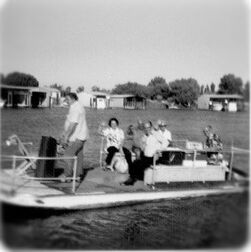
The harbor began to fill with boats and people through the mid- and late 60s. During this period the boat owners operated the ferry. Then the job shifted to the Harbormaster, first hired around 1969-70, when the apartment was added to the clubhouse (the job was then called “caretaker”.) The last person to leave the island left the ferry in the levee-side slip (at the foot of the existing gangway) where it stayed until the arrival of a boat owner needing transportation to the island. He then took the ferry over to the island and went about his business. When the ferry buzzer rang, the first arrival then took the ferry to pick up the new arrivals. This continued until the last person left the island and the process repeated.
Now that there was an outside area, Sam started thinking of building the present bar and lounge. This is where Sam made his second large mistake. The sundeck was built on the same short “pile butts”. Rather than just ripping up the sun decking and driving standard piles for a new foundation, “Hurry Up Sam” built the new bar on top of the sundeck. These pile butts started sinking like the ones under the original building and eventually needed expensive and hard-to-install steel support (paid for by the Martini family in 1984-5). But the new lounge area, built on the old deck in 1980 by Sam and club members, was an immediate hit.
At the same time that the pile butts were driven for the clubhouse, several were driven in the water just south of the clubhouse for future use. Sam always talked about building a bait shack, gas dock, sales office, or maybe a boat brokerage office. This wasn’t just an idle thought. Beginning in about 1977, Sam and partner and club member Lenny Gomes did start selling boats on Caliente Isle. He owned the docks and the club didn’t seem to mind him having two or three shiny new 43’ and 48’ Nautaline houseboats on display on what is now the pump out dock. Sam and Lenny had the only dealership for these boats and probably sold 30-40 of them. Many of these boats ended up in the harbor with the new owners becoming club members, making the club officers happy.
One Nautaline owner, Bob Hamburger, went up the chairs to become Commodore in 1983. The last of the Nautaline houseboats left the harbor in the 1990s but many can be found in the Delta today. Every one of them was purchased at Caliente Isle. It is fortunate that Sam didn’t follow through with building some kind of commercial building on the island. If Sam had gone ahead with his building plans, not only would that have significantly changed what Caliente was at the time and still is today, but because these pilings are now the foundation for the popular "Martini Deck" adjacent to the club's bar. This well-placed deck and new surrounding walkways were built in 2003-04 by club members (now known as the Royal Order of the 11th Board -- referring to the deck's 11th plank -- an informal construction milestone -- still celebrated today as a club tradition). These members and many others continued to work hand-in-hand with the Island's owners, as was the tradition from CIYC's earliest days.
Now that there was an outside area, Sam started thinking of building the present bar and lounge. This is where Sam made his second large mistake. The sundeck was built on the same short “pile butts”. Rather than just ripping up the sun decking and driving standard piles for a new foundation, “Hurry Up Sam” built the new bar on top of the sundeck. These pile butts started sinking like the ones under the original building and eventually needed expensive and hard-to-install steel support (paid for by the Martini family in 1984-5). But the new lounge area, built on the old deck in 1980 by Sam and club members, was an immediate hit.
At the same time that the pile butts were driven for the clubhouse, several were driven in the water just south of the clubhouse for future use. Sam always talked about building a bait shack, gas dock, sales office, or maybe a boat brokerage office. This wasn’t just an idle thought. Beginning in about 1977, Sam and partner and club member Lenny Gomes did start selling boats on Caliente Isle. He owned the docks and the club didn’t seem to mind him having two or three shiny new 43’ and 48’ Nautaline houseboats on display on what is now the pump out dock. Sam and Lenny had the only dealership for these boats and probably sold 30-40 of them. Many of these boats ended up in the harbor with the new owners becoming club members, making the club officers happy.
One Nautaline owner, Bob Hamburger, went up the chairs to become Commodore in 1983. The last of the Nautaline houseboats left the harbor in the 1990s but many can be found in the Delta today. Every one of them was purchased at Caliente Isle. It is fortunate that Sam didn’t follow through with building some kind of commercial building on the island. If Sam had gone ahead with his building plans, not only would that have significantly changed what Caliente was at the time and still is today, but because these pilings are now the foundation for the popular "Martini Deck" adjacent to the club's bar. This well-placed deck and new surrounding walkways were built in 2003-04 by club members (now known as the Royal Order of the 11th Board -- referring to the deck's 11th plank -- an informal construction milestone -- still celebrated today as a club tradition). These members and many others continued to work hand-in-hand with the Island's owners, as was the tradition from CIYC's earliest days.
Sam Martini: The Founder of Caliente Isle Yacht Club
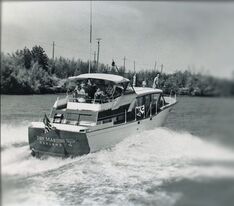
Sam Martini had a small business in Oakland when he got his start in boating in the mid-50s. His two children were young as were his brother’s kids (Vince was Sam’s hard working construction partner at Caliente Isle). His first boat was a plywood runabout that was used for family water skiing. Sam moved on to a 30’ Steel Craft that he berthed in Alameda, and then in 1959 he purchased a 35’ Chris craft Constellation and joined the Oakland Yacht Club. Like so many boaters, it seems that bigger always looks better, and only nine months later he bought a new 41’ Chris Conqueror. Oakland Yacht Club was a significant club during the period, located on the opposite side of the Oakland estuary than the case today, and in 1965 Sam served as its Commodore.
Sam bought a new 47’ Chris Craft cruiser in 1965, moving into the first new slip at what would become Sam’s Caliente Isle Yacht Club. He named it the Dry Martini. His son, Frank, was the skipper of his own Chris Craft, the Extra Dry Martini, and was a member of the club since its 1967 inception, serving as the Commodore in 1974. (Frank died in a traffic accident in the 1990s.) Sam’s daughter Sharon DuFrane along with her husband John owned the floating home that was berthed next to the footbridge and became CIYC members in 1981. Both have served on the board, Sharon as Entertainment Director and John as Port Captain. It hasn’t been that many years since Sam’s grandchildren, Cindy and Frankie Jr., were fixtures on the island as was his nephew Robert Martini who still lives on Bethel Island. The extended Martini family rarely visit these days but all showed up for “Martini (Founders) Day” occasionally.
Most of today’s club members don’t know of Sam’s racing accomplishments. The Dry Martini, carrying race #17, won many races in the years after 1959 and his first race. Anybody involved in the race hobby knew Sam to be the champion skipper for many years. While predicted log racers are a relatively small group today, for many years 100 or more boats were competing in a single race and there were as many as a dozen races a year. The Over-the-Bottom contests are run at 5, 8 or 10 knots, and they are navigational tests that take great skill and more than a little bit of luck. These race skippers can tell you just how long it will take them to cover a certain distance in their boats at a certain speed, figuring in the tide and current, and it ruins their weekend if they are more than a few seconds off after covering 15 to 20 miles. Sam broke records in both the predicted log and over-the-bottom racing programs and was the overall champion in ’67, ’68, ’74. ’76 and ’77. He was the Commodore of the Predicted Log Racing Association in 1964 and was the 1961-62 champion of that group. He retired from racing to become Race Manager for the Northern California Power Cruisers Association (NCPCA).
CIYC was a hot bed of predicted log and NCPCA racing in the 1960s and 70s. Thinking about his legacy, Sam was proud to have realized his dream of creating a place, Caliente Isle, where so many people learned the fine art of power boat racing and to have been the founder of a place where so many people enjoyed themselves. When asked one evening while sitting around the fire in the clubhouse, what he enjoyed doing most he said it was doing exactly what he was doing at that moment, enjoying the club and the Caliente people.
Sam bought a new 47’ Chris Craft cruiser in 1965, moving into the first new slip at what would become Sam’s Caliente Isle Yacht Club. He named it the Dry Martini. His son, Frank, was the skipper of his own Chris Craft, the Extra Dry Martini, and was a member of the club since its 1967 inception, serving as the Commodore in 1974. (Frank died in a traffic accident in the 1990s.) Sam’s daughter Sharon DuFrane along with her husband John owned the floating home that was berthed next to the footbridge and became CIYC members in 1981. Both have served on the board, Sharon as Entertainment Director and John as Port Captain. It hasn’t been that many years since Sam’s grandchildren, Cindy and Frankie Jr., were fixtures on the island as was his nephew Robert Martini who still lives on Bethel Island. The extended Martini family rarely visit these days but all showed up for “Martini (Founders) Day” occasionally.
Most of today’s club members don’t know of Sam’s racing accomplishments. The Dry Martini, carrying race #17, won many races in the years after 1959 and his first race. Anybody involved in the race hobby knew Sam to be the champion skipper for many years. While predicted log racers are a relatively small group today, for many years 100 or more boats were competing in a single race and there were as many as a dozen races a year. The Over-the-Bottom contests are run at 5, 8 or 10 knots, and they are navigational tests that take great skill and more than a little bit of luck. These race skippers can tell you just how long it will take them to cover a certain distance in their boats at a certain speed, figuring in the tide and current, and it ruins their weekend if they are more than a few seconds off after covering 15 to 20 miles. Sam broke records in both the predicted log and over-the-bottom racing programs and was the overall champion in ’67, ’68, ’74. ’76 and ’77. He was the Commodore of the Predicted Log Racing Association in 1964 and was the 1961-62 champion of that group. He retired from racing to become Race Manager for the Northern California Power Cruisers Association (NCPCA).
CIYC was a hot bed of predicted log and NCPCA racing in the 1960s and 70s. Thinking about his legacy, Sam was proud to have realized his dream of creating a place, Caliente Isle, where so many people learned the fine art of power boat racing and to have been the founder of a place where so many people enjoyed themselves. When asked one evening while sitting around the fire in the clubhouse, what he enjoyed doing most he said it was doing exactly what he was doing at that moment, enjoying the club and the Caliente people.
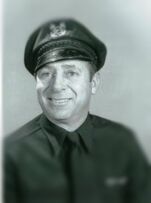
He had hoped to someday retire from his automotive garage business and live aboard the Dry Martini at Caliente.
Sam passed away on October 5, 1981 after a yearlong, courageous battle with cancer. The Caliente Isle Founders Award (pictured in this directory) is given annually to deserving club members. This prestigious award is the chronograph Sam used in the many races in which he was a consistent winner.
Caliente Isle Yacht Club: The Visionaries That Followed Sam Martini
Sam Martini was just the first of the several visionaries to transform the little island on Taylor Slough into what we today know as Caliente Isle Yacht Club and Caliente Harbor. After Sam died in 1981, his wife Lucile, who passed away in 2009, took over the operation of the property with her daughter and son-in-law Sharon and John DuFrane, both of whom remained active CIYC members for many years
Caliente Isle Yacht Club was always a legal entity separate from Caliente Harbor, Inc., the corporation that owns the island, the berths and the property on the levee. The lines between the two were a bit blurry to the uninformed. Sam founded the club and required that all berthers be members in good standing of the club. He looked to club members to help with projects around the clubhouse and Lucile kept the same concept alive.
Lucile and family operated the island in ways little different than Sam’s ways. The family invested heavily in new steel framing under the lounge area of the clubhouse to help stabilize that end of the building. The traditions of CIYC continued, with a few changes in cruise destinations, in party themes and in the look of the interior and immediate exterior of the clubhouse. For example, the club remodeled the galley several times, put in new cabinets, flooring and decorations in the dining room and completely redid the lounge area.
Membership moved to upwards of 110 members in the 1980s and early 90s, and slipped down following economic and other trends in the late 1990s. By this time, the Martini family felt it was time to sell the property, which they did in 1999.
Club members Craig and Nola Dosch purchased the property, keeping the island “in the family.” Craig and Nola had several boats in the time they were at CIYC. Their first was a vintage 36’ Trojan cruiser that went well with Craig’s woody runabout. They then purchased the first of their two Michelson boats named Maui Moon. The first was a 43’ model and the second a fine 48 footer. They also enjoyed their bright red 22’ Donzi speedboat. Craig especially enjoyed its 70 mph, usually reached with fellow club members as passengers having the wits scared out of them.
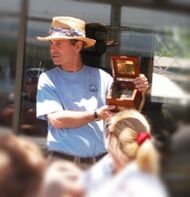
Craig and Nola wanted nearly everything about the traditions of CIYC to remain the same as they took over ownership. They continued with the policy that all berthers would need to be club members. Craig started to rebuild the berths, focusing on increasing the height of many small ones on the north dock that were becoming increasingly hard to rent. Craig looked to club members to help on projects around the clubhouse, paying for all the materials and leading club members in the construction of new walkways, the Martini Deck, the pier and the gangway to the guest dock. In return, he worked to keep berth fees on the low end of the Bethel Island spectrum
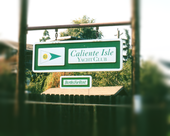
Craig, like Sam, was a visionary. He saw the new deck as something that would honor Sam Martini and authored the words that were on the plaque on the deck.
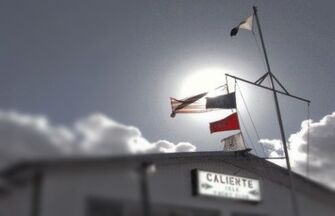
He talked about a new patio and horseshoe pits. Like Sam, he wanted the island to be a place where people could relax on their boats or in the clubhouse and just have fun. Craig was a very active member from the time he and Nola joined CIYC in 1996 and was a friend to all during his and Nola’s ownership. The two of them took over the islander newsletter shortly after joining and had that responsibility for several years.
Regrettably, Craig got sick in the spring of 2005 in a battle with cancer. We lost a special club member on Christmas Day of that year. The pier connecting the Martini Deck with the guest dock and the patio had a plaque designating it as the Craig Dosch Memorial Dock. It was a fine place to look out at the water, Mount Diablo and beyond and think about the special place this tiny island on Taylor Slough has become.
Nola took over the operation of the property immediately but she decided to sell the island the following year to its current owner (as of 2016), Robert Adams/Premier International.
Regrettably, Craig got sick in the spring of 2005 in a battle with cancer. We lost a special club member on Christmas Day of that year. The pier connecting the Martini Deck with the guest dock and the patio had a plaque designating it as the Craig Dosch Memorial Dock. It was a fine place to look out at the water, Mount Diablo and beyond and think about the special place this tiny island on Taylor Slough has become.
Nola took over the operation of the property immediately but she decided to sell the island the following year to its current owner (as of 2016), Robert Adams/Premier International.
A New Beginning...
2011 marked the end of an era for Caliente Isle Yacht Club at Caliente Isle, Bethel Island. Most of the member’s boats had left Caliente Harbor and on December 31st the Club decided not to renew our lease, and vacated the Clubhouse and Caliente Isle premises. We will remember 2012 as a year of transition for Caliente Isle Yacht Club. Friendships remain strong among our members as we bond together with an emphasis as a Cruising Club. Many of the factors that brought the club into existence remain in place: vision, drive and commitment to boating and fun.
2017 - Caliente Isle Yacht Club Turns 50! |
